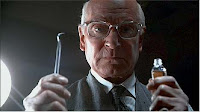 Here in the top of the poster we have established what actors are starring in out thriller (Tom Vale and Taylor Gladwin). The font has been chosen to be put in black, which connotations resemble death or darkness, the font used does not join the letters. This makes it easier for people to read but it also has an element of creepiness. Tom Vales name also has a red background of blood whilst Taylor’s is in white. This could infer that Tom is playing the character who has danger centered around him, maybe meaning he is the villain. This come from the connotations of the colour red.
Here in the top of the poster we have established what actors are starring in out thriller (Tom Vale and Taylor Gladwin). The font has been chosen to be put in black, which connotations resemble death or darkness, the font used does not join the letters. This makes it easier for people to read but it also has an element of creepiness. Tom Vales name also has a red background of blood whilst Taylor’s is in white. This could infer that Tom is playing the character who has danger centered around him, maybe meaning he is the villain. This come from the connotations of the colour red.
We have used an image of a knife to show the type of film that it is. It also suggests what props we have used in the making of the film and that it has some significance to the movie. As well as this, in the reflection of the knife the reflection of a person can be seen. This leads the audience to create their own enigmas to whether he is the villain or innocent.

This states the name of the film, again the colour of the font is red which represents danger and worry but also keeps with the theme of blood. Secondly the font it different, it doesn’t have the appearance to something that would be on a Disney film. It is plain, to the point and used in everyday life which is what most thrillers are set about.

The definition to the word disposition we found to be quite creepy, again this was used on the poster to suggest what the film is about, especially the last word ’torture’.
The colour scheme of the poster consists of whites, reds and blacks. We used white as it connotates innocence, isolation and perhaps a degree of psychological craziness. We wanted to contrast this with the use of red, which means danger, suggesting there is a fight between the innocent and guilty.

Lastly, at the bottom is shown the credits of who was in the making of the film. This includes the directors, editors, scripts and names of institutions and distributors.
The colour scheme of the poster consists of whites, reds and blacks. We used white as it connotates innocence, isolation and perhaps a degree of psychological craziness. We wanted to contrast this with the use of red, which means danger, suggesting there is a fight between the innocent and guilty.

Lastly, at the bottom is shown the credits of who was in the making of the film. This includes the directors, editors, scripts and names of institutions and distributors.













































